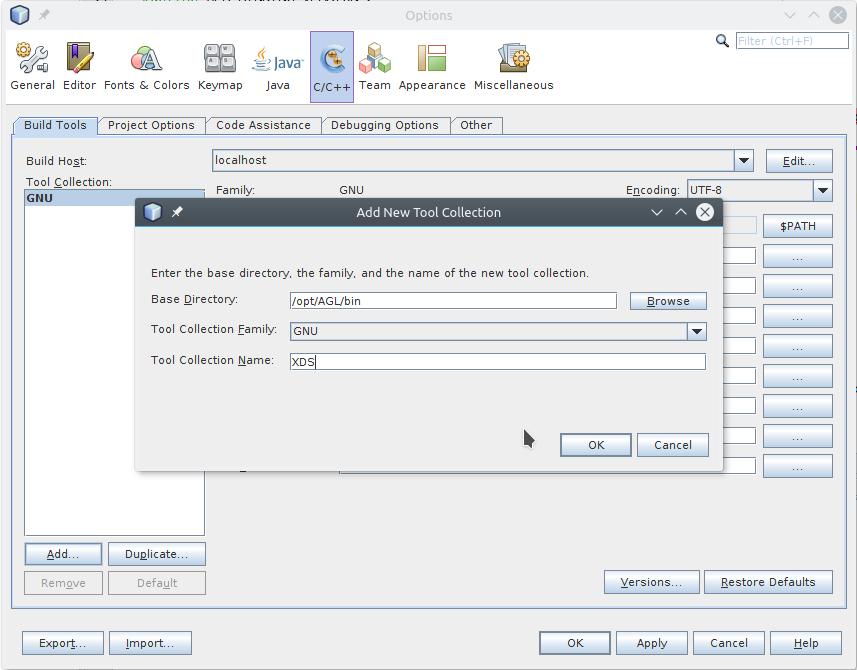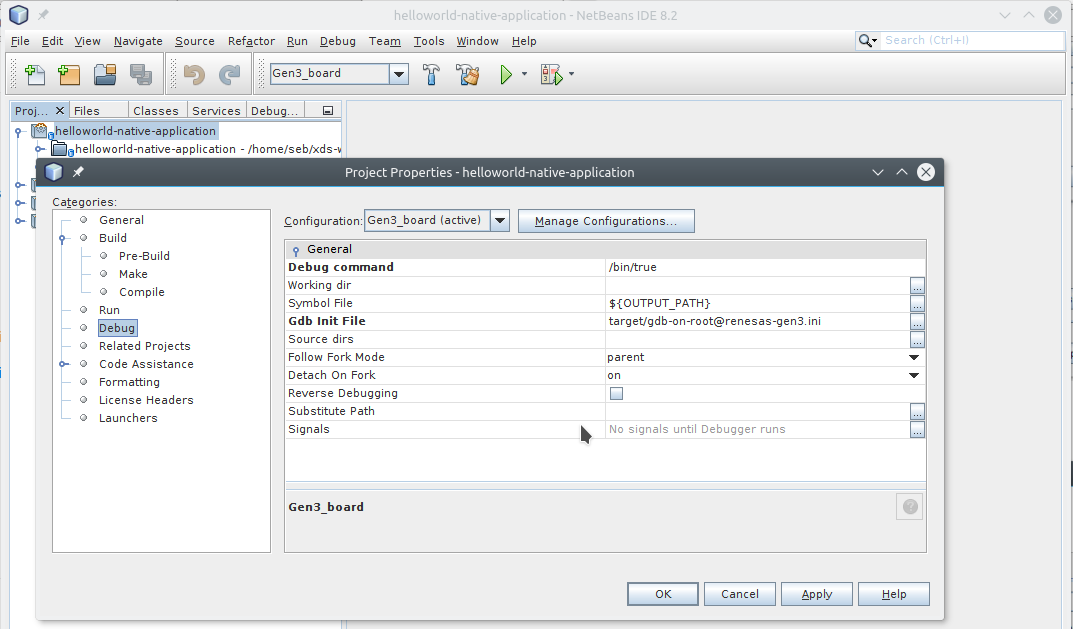Debug your first AGL application
Debug is based on gdb and you need to use xds-gdb as a wrapper on gdb to cross-debug your application.
This tool allows you to debug an application built with an xds-server without the need to install gdb or any cross tool.
Two debugging models are supported:
-
native debugging
-
XDS remote debugging requiring an XDS server and allowing cross debug your application.
By default XDS remote debug is used and you need to define XDS_NATIVE_GDB
variable to use native gdb debug mode instead.
SEE ALSO: xds-server, a web server used to remotely cross build applications. SEE ALSO: xds-exec, wrappers on
execcommand that allows to cross build your application throughxds-server.
Configuration
xds-gdb configuration is defined by variables (see listed below).
These variables may be set using :
- environment variables (inherited),
- or a config file set with
XDS_CONFIGenvironment variable, for example:XDS_CONFIG=/tmp/my_xds_gdb_config.env xds-gdb - or by setting variables within a gdb ini file (see details below),
- or a “user” config file located in following directory (first found is taken):
- $(CURRENT_DIRECTORY)/.xds-gdb.env
- $(CURRENT_DIRECTORY)/../xds-gdb.env
- $(CURRENT_DIRECTORY)/target/xds-gdb.env
- $(HOME)/.config/xds/xds-gdb.env
Configuration Variables
XDS_CONFIG
Config file defining XDS_xxx configuration variables. Variables of this file
will overwrite inherited environment variables. Variables definition may be
prefixed or not by “export” keyword.
Here is an example of configuration file
# for example:
# MY_PROJECT_DIR=/home/seb/xds-workspace/helloworld-native-application
cat > $MY_PROJECT_DIR/xds-gen3.conf << EOF
export XDS_SERVER_URL=http://docker:8000
export XDS_PROJECT_ID=IW7B4EE-DBY4Z74_myProject
export XDS_SDK_ID=poky-agl_aarch64_4.0.1
EOF
XDS_LOGLEVEL
Set logging level (supported levels: panic, fatal, error, warn, info, debug)
XDS_LOGFILE
Set logging file, default /tmp/xds-gdb.log.
XDS_NATIVE_GDB
Use native gdb mode instead of remote XDS server mode.
XDS_PROJECT_ID (mandatory with XDS server mode)
Project ID you want to build
XDS_RPATH
Relative path into project
XDS_SDK_ID (mandatory with XDS server mode)
Cross Sdk ID to use to build project
XDS_SERVER_URL (mandatory with XDS server mode)
Remote XDS server url
Configuration variables set within gdb init command file
Above XDS_xxx variables may also be defined within gdb init command file
(see –command or -x option of genuine Gdb).
You must respect the following syntax: commented line including :XDS-ENV: tag
Example of gdb init file where we define project and sdk ID:
# :XDS-ENV: XDS_PROJECT_ID=IW7B4EE-DBY4Z74_myProject
# :XDS-ENV: XDS_SDK_ID=poky-agl_aarch64_4.0.1
Using xds-gdb from command line
XDS remote debugging mode
First the project you want to debug must be declared on an xds-server and this project may also has been built using this xds-server (see xds-server for more details).
So to debug it you need to know the xds-server url (eg. http://docker:8000),
you also need the project and sdk unique id. You can find these IDs in project
page of XDS dashboard or you can get them from command line using the --list
option.
This option lists all existing projects ID:
XDS_SERVER_URL=http://docker:8000 xds-gdb --list
Now to refer your project, just set XDS_PROJECT_ID and XDS_SDK_ID variables.
You are now ready to use xds-gdb to for example cross debug your project.
Here is an example to build and debug a project based on CMakefile and
AGL app-templates:
# Go into your project directory (for example helloworld-native-application)
cd ~/xds-workspace
git clone https://github.com/iotbzh/helloworld-native-application.git
cd helloworld-service
# Declare your project on xds-server
# <for now, you can only do this step using xds HTML dashboard (see xds-server doc)>
# Define XDS config
cat <<EOF >./xds-config.env
XDS_SERVER_URL=http://docker:8000
XDS_PROJECT_ID=IW7B4EE-DBY4Z74_myProject
XDS_SDK_ID=poky-agl_aarch64_4.0.1
EOF
# Tell to xds-exec and xds-gdb which is your config file
export XDS_CONFIG=../xds-gen3.conf
# Create a new build directory
mkdir build && cd build
# Start remote cross build
xds-exec -- cmake -DRSYNC_TARGET=root@myTarget ..
xds-exec -- make
xds-exec -- make remote-target-populate
# Start debugging
xds-gdb -x target/[email protected]
Note: : helloworld-native-application project is an AGL project based on app-templates (included as a git submodule). This CMake templating, used to develop application with the AGL Application Framework, will automatically generate makefile rules (eg.
remote-target-populate) or scripts (eg.build/target/xxxscripts).
For more info about app-template, please refer to this documentation.
Native debugging
To enable native debugging mode, you need to define XDS_NATIVE_GDB variable.
Using xds-gdb within an IDE
Netbeans
Netbeans 8.x :
- Open menu Tools -> Options
-
Open C/C++ tab, in Build Tools sub-tab, click on Add button:

-
Then, you should set Make Command and Debugger Command to point to xds tools:

-
Finally click on OK button.
-
-
Edit project properties (using menu File -> Project Properties) to update Debug settings:
-
Be sure that “Gen3 board” configuration is selected
- Select Run category, and set:
- Run Command:
target/[email protected](script name may depend of RSYNC_TARGET variable you set in pre-build command) - Run Directory:
build_gen3
- Run Command:
- Select Debug category, and set:
- Debug command:
/bin/true - Working Directory: empty field
- Gdb Init File:
target/[email protected](script name may depend of RSYNC_TARGET variable you set in pre-build command)

- Debug command:
- Click on Apply and then OK button to save settings
-
You can now start debugging your application with menu Debug -> Debug Project (or CTRL+F5 shortcut)
Others IDE
Coming soon…